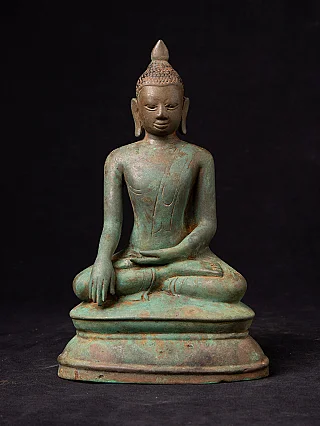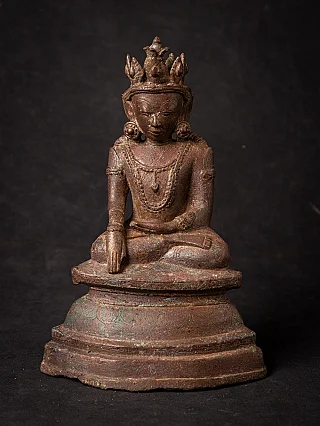Arakan period: 575 - 1948

The Arakan period (575 - 1948) marks a significant era in Burmese history, with its influence on art, culture, and religious practices. The Arakan kingdom, located in the western part of modern-day Myanmar (formerly Burma), was home to a rich and diverse Buddhist tradition. With its unique blend of cultural influences and artistic styles, the Arakan period is recognized for creating stunning Buddha statues that embody the spiritual and artistic advancements of the time.
The kingdom's Dhanyawaddy, Vesali, Laymro, and Mrauk-U dynasties contributed to developing a distinct visual and symbolic language in art. The region was an important center of Buddhist devotion, and its statues continue to serve as crucial artifacts, offering a window into the beliefs and artistic expressions of the time.
Buddha statues from the Arakan period

The ancient Arakan kingdom was located in the west of Burma in the now called Rakhine state. With four dynastic eras; Dhanyawaddy, Vesali, Laymro and Mrauk-U, Arakan is thought to have been an independent nation for over 5,000 years until it was conquered by the Burmese (Ava) in 1784. At its peak the kingdom was taking tribute from as far away as Mushidabad, India in the west to the Mon capital of Pegu in the east and much of lower Burma. There are still hundreds of ancient pagodas, temples, shrines and Buddha statues located in Arakan, especially in the old capital, Mrauk-U. The most famous of these works is the Mahamuni Buddha Image but that is now in Mandalay in central Burma.
History
The Arakan kingdom lasted over 5,000 years and was known for its strategic location west of Burma (now Myanmar). The kingdom flourished under different dynasties, particularly the Mrauk-U period. At its peak, Arakan controlled a vast territory, with tributary relations extending to India and down to the Mon capital of Pegu. The Arakan kingdom remained independent until it was conquered by the Burmese in 1784.
Arakan is famous for its Mahamuni Buddha image, one of the most revered Buddha statues, although it is now housed in Mandalay, Myanmar. The region remains rich in historical sites, with hundreds of ancient pagodas, temples, shrines, and Buddha statues still standing today, especially in the old capital, Mrauk-U.
Characteristics
-small.jpg)
Buddha statues from the Arakan period are known for their distinct features, influenced by Pali art and the region's stylistic elements. These statues typically depict the Buddha in a seated position, often cross-legged, with a downward gaze and fingers in the Bhumisparsha mudra (the gesture of touching the earth).
Arakanese Buddha images are particularly notable for their large Ushnisha (the cranial bump) on the Buddha's head. The crowned Buddha images ( Jambupati) are adorned with a shorter crown wing and intricate rope details. These statues are crafted with great attention to detail, highlighting the region's commitment to artistic and spiritual representation.
Symbolism
The Arakan period Buddha statues carry deep symbolic meaning, reflecting the Buddhist teachings of enlightenment, tranquility, and spiritual awakening. The Bhumisparsha mudra, in which the Buddha touches the earth, represents the moment of enlightenment, symbolizing the Buddha's triumph over Mara, the force of illusion.
Arakanese art is also characterized by the Buddha's serene expression and downward gaze, symbolizing the Buddha's connection with the earth and mindfulness in meditation. The Ushnisha on the Buddha's head symbolizes wisdom, while the crown represents royalty and spiritual authority.
Evolution and Influences
The art of the Arakan period evolved through various cultural and religious influences, including Indian, Thai, and local Burmese traditions. The kingdom's position as a trade and cultural exchange center allowed it to incorporate new artistic techniques and spiritual practices, enriching its indigenous style.
This blending of influences can be seen in the intricate designs and symbolism of the Buddha statues. The cross-cultural interaction between the Arakan kingdom, neighboring Thailand, and India allowed Burmese artisans to innovate while respecting their traditions.
Importance
The Buddha statues from the Arakan period are vital for understanding Burma's spiritual and cultural evolution (Myanmar). These statues offer insight into the religious beliefs of the Arakanese people but also shed light on the broader historical context of the region during the Konbaung Dynasty and beyond.
Preserving these statues is essential for maintaining the cultural memory of the Tai-Shan people and for future generations to appreciate the artistic and spiritual legacy of the Arakan period. Museums, cultural organizations, and private collectors play a critical role in ensuring the longevity of these works, safeguarding the region's artistic heritage.
Share this page



























